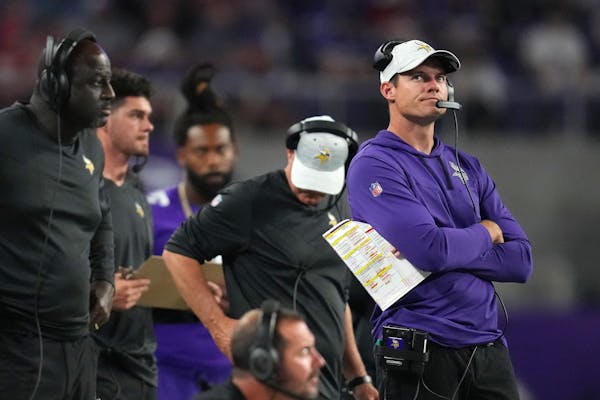 See
more of the story
See
more of the story
A horn blows and Vikings players scatter across two practice fields in a scene that resembles a subway at rush hour.
A full training camp roster requires a lot of hands to manage, but Kevin O'Connell's staff has it covered, and then some.
O'Connell assembled a staff of 28 assistant coaches in his first season, a record for the organization. Along with traditional coordinator roles, O'Connell hired a game management coordinator (Ryan Cordell) and an assistant head coach (Mike Pettine) who previously served as head coach of the Cleveland Browns.
The staff includes a quarterbacks coach and an assistant quarterbacks coach to oversee three quarterbacks on the roster.
There is an inside linebackers coach, an outside linebackers coach and an assistant linebackers coach.
Dwight Schrute would approve of this staff.
"When you can have a 1-to-1 coach-to-position ratio on two fields, I think it's great for the players," O'Connell said. "It's great for every single person on our team to feel like they're being watched and developed and coached up hard."
A jumbo-sized coaching staff is not unique to the Vikings. This has subtly become another tentacle in the arm's race that governs all sports leagues, professional and college.
Skyrocketing salaries and opulent facilities receive more attention as flashy signs of a team's commitment, but a trend of beefing up coaching staffs is gaining steam.
Consider:
Nick Saban's football staff at Alabama features 13 analysts who assist the full-time coaches, graduate assistants and special assistants to the head coach. The group of analysts includes one former SEC head coach and a defensive coach with 30 years of experience between the NFL and major college football.
Former Utah Jazz head coach Quin Snyder had 11 assistants on his staff last season. NBA teams carry 15 players on the roster during the season.
Though not technically a member of Rocco Baldelli's field staff, the Twins baseball operations department employs a run creation coordinator and a run prevention coordinator.
These examples cause one to stop and contemplate: How did teams survive previously?
Poor Bud Grant had only four assistants on his 1967 Vikings staff.
Former Gophers coach Glen Mason recalls returning to the football facility as part of the Big Ten Network broadcast crew and, as he sat for a production meeting with then-coach Jerry Kill, noticing chairs lined along the wall surrounding their large table.
Mason didn't have those chairs when he coached in the early 2000s because he didn't need them. His staff could fit at the conference table. Kill had a staff meeting after the broadcast crew finished its conversation.
"The door opened and all these people started coming in," Mason said. "I'm looking and thinking, Who the heck are all these guys?"
Specialization sparks growth
Times change, things evolve. Just like SUVs and TVs, coaching staffs have ballooned in size over the years.
Money is at the root of it, of course. Teams have far more financial resources at their disposal now than ever before, so they identified another area in which to spend.
The unspoken motto: If you've got it, spend it.
Coaches fear falling behind rivals in any facet of the arms' race. If they see an opponent's coaching staff multiplying, they will want something similar. That's just the nature of sports.
Head coaches say staff size isn't a status symbol. They point to several benefits of having more coaches.
"People are becoming more highly specialized," said Timberwolves coach Chris Finch, who has six assistants.
NBA teams are hiring assistant coaches to oversee specific areas. A team might employ a shooting coach, a coach to run the defense, an architect for the offense, multiple player development coaches.
"The modern athlete wants more personal attention," Finch said. "It's all about relationship building."
That personal touch is easier to accomplish if an assistant coach has either one-on-one sessions or only a few players at a time when studying video, or doing skill development work after practice, or spending time with players away from the facility.
Finch noted that it's not just coaching staffs that are expanding in professional sports. Front offices have created new positions beyond traditional roles, along with the performance side as teams put more emphasis on training, sports science and analytics.
More coaches mean more messages and ideas being delivered to players, which Finch admits can be tricky for a head coach.
"You've got to make sure the right messages and the same messages are going out," he said. "We still want all of our coaches to have a relationship with all of our players. You risk some territorial battles sometimes if you don't have a healthy functioning staff."
Part of O'Connell's plan in hiring a large staff involves being prepared for when his assistants leave for other jobs. Turnover is a way of life in the coaching profession. Coaches are constantly coming and going.
O'Connell hopes that by having multiple coaches at every position he is insulating his staff and players from major disruption if an assistant moves on.
"We've got some great coaches right here on campus that are ready to step into some roles," he said.
Similar to his roster, O'Connell wants depth on his coaching staff, an assistant to the assistant at different positions. This is a new frontier in the search for a competitive edge.





